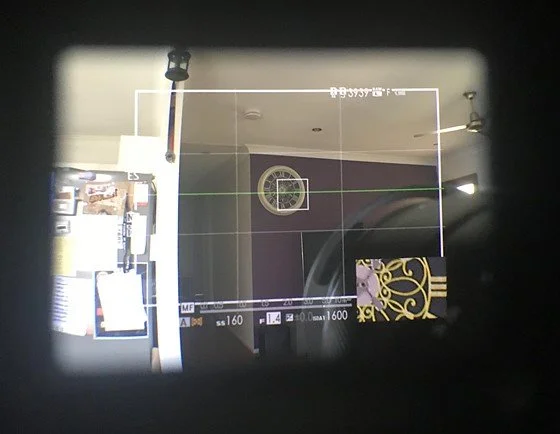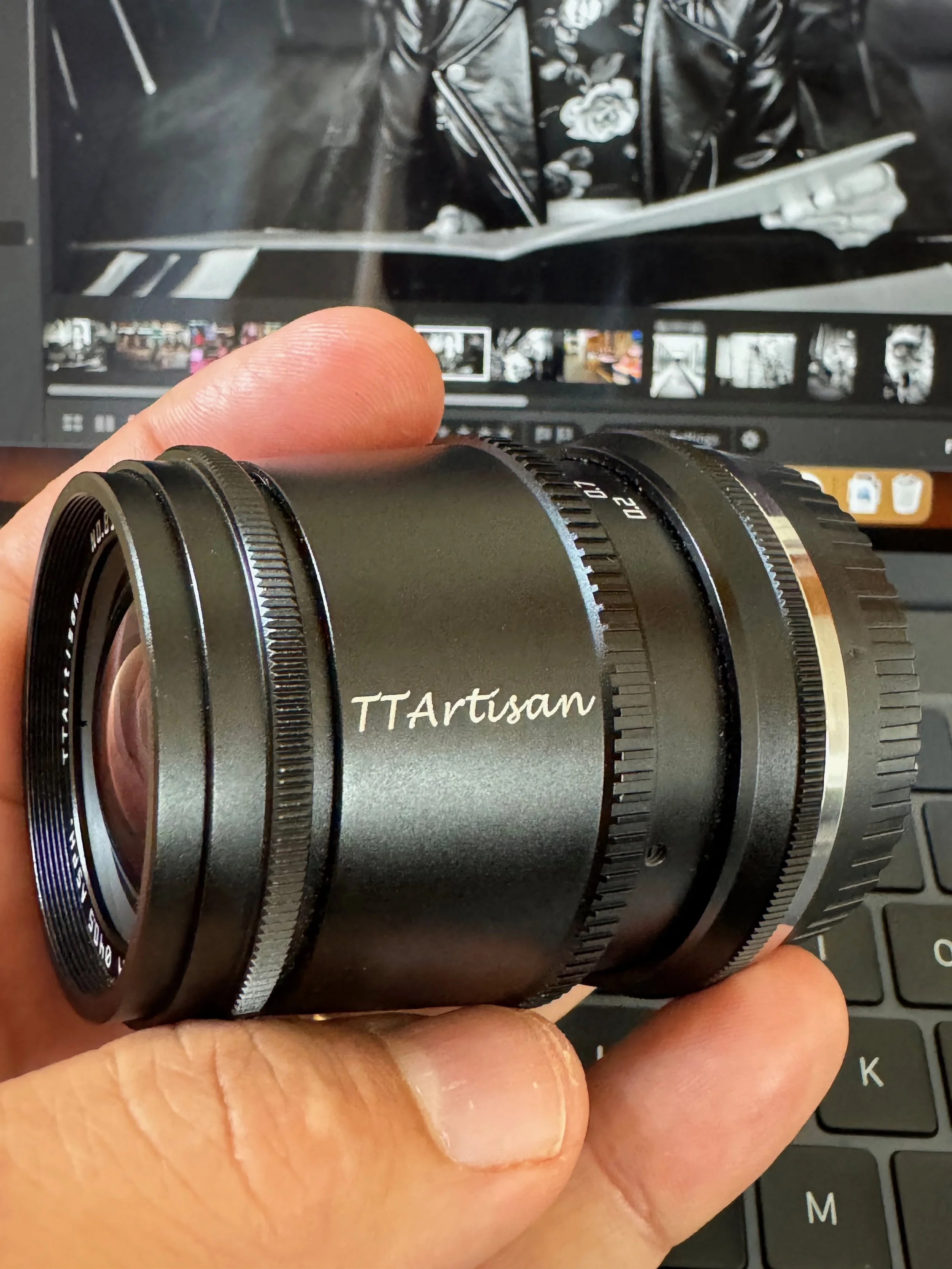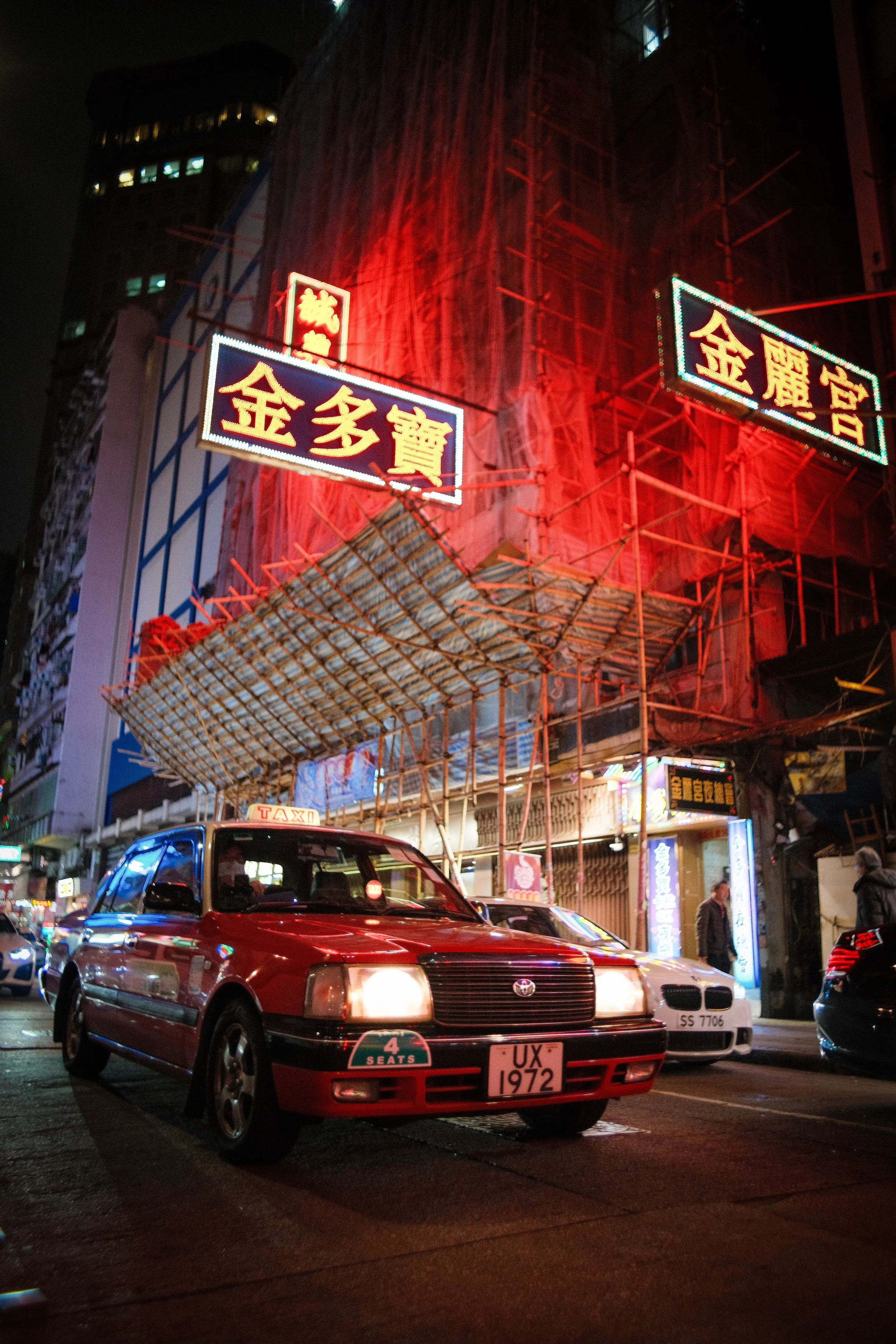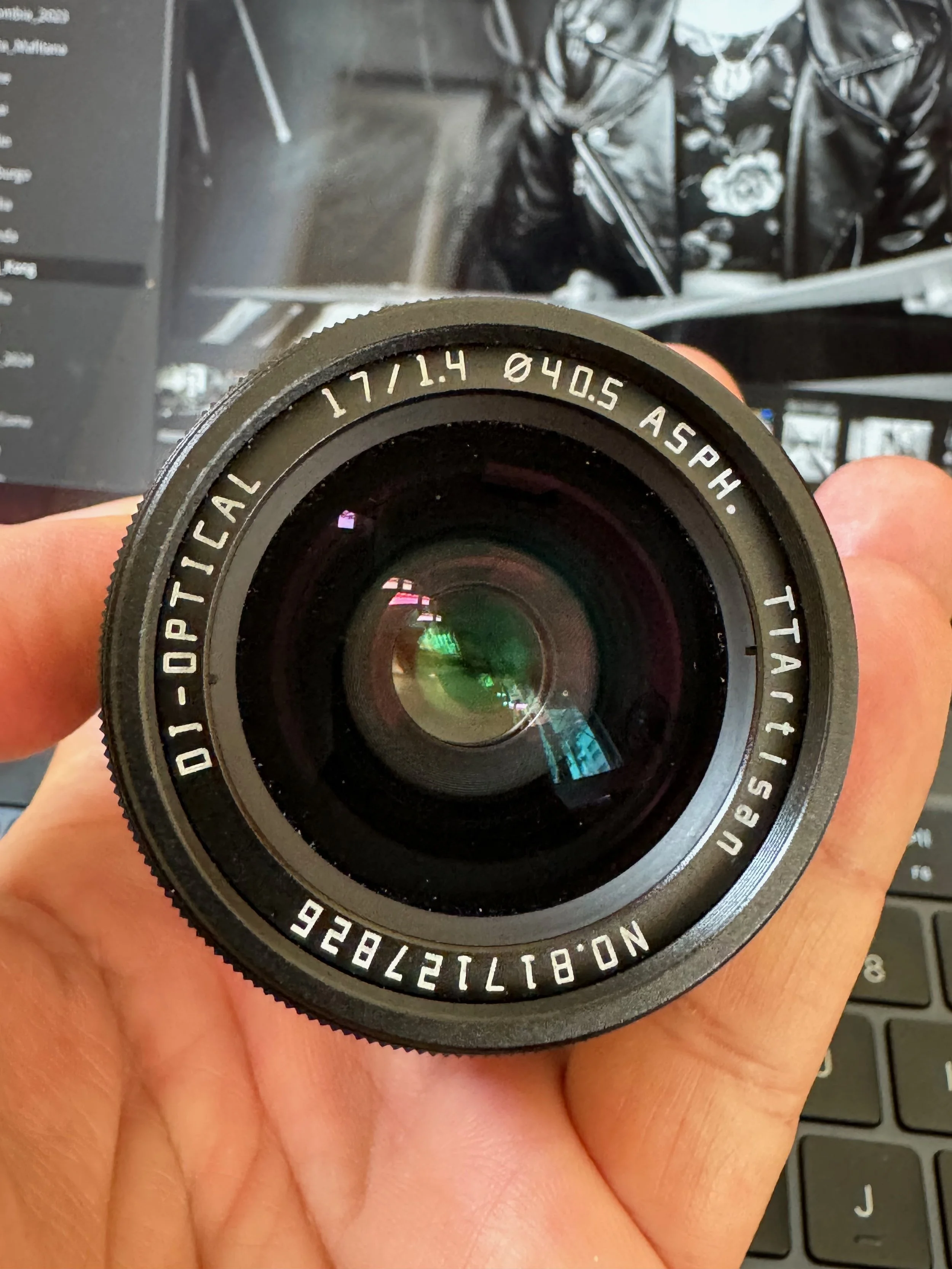If I could use only one lens in my camera 📷
In over 20 years of photography, I ended up finding a nice balance between performance and user experience with Fujifilm. While other brands like Leica may be more popular about the user experience thing, Fujifilm cameras always performed well to me and with a nostalgic feel when comes to those tactile dials that I love or the color rendering of film simulations.
However, when the subject comes to lenses, Fujifilm lenses are great but mostly auto-focus lenses. And here begins my journey searching for a manual-focus lens on third party brands that could help me to extend my experience getting closer to that analog photography shooting style.
Image taken with TTArtisan 17mm f/1.4 lens @ 1/400, ISO 200 - Fujifilm Xpro-3 camera
First, how auto-focus lens may differ from manual-focus lens?
Auto-focus and manual-focus lenses serve distinct purposes in photography, each offering unique advantages depending on the shooting scenario.
An auto-focus lens simplifies the focusing process by automatically adjusting the lens elements to achieve sharp focus on the subject when the shutter button is pressed. This feature allows photographers to concentrate more on composition and timing, making it ideal for fast-paced or unpredictable environments like wildlife or sports photography.
Conversely, manual-focus lenses require the photographer to adjust the focus ring manually to achieve sharpness before capturing the image. This method demands greater control and precision, which can be beneficial in situations where auto-focus may struggle, such as low-light conditions, macro photography, or creative shots requiring selective focus. The camera typically provides feedback (such as a beep or on-screen indicator) to confirm when focus is achieved.
Understanding the differences between these two focusing mechanisms can help photographers choose the right lens and technique for their desired outcome, ensuring every moment is captured with clarity and intent.
Image taken with TTArtisan 17mm f/1.4 lens @ 1/250, ISO 800 - Fujifilm Xpro-3 camera
How difficult may be to get good photos with a manual-focus lens?
Like any manual task, practice leads to perfection. This is where the true challenge lies, making the use of manual-focus lenses both exciting and deeply rewarding; at least from my perspective. Mastering manual focus requires patience, precision, and a keen eye, but the results are unparalleled. Each shot becomes a deliberate creation, a moment truly captured by your own hand, allowing for a more intimate connection with your subject and the art of photography itself.
This type of lens or photography technique is becoming increasingly popular because it demands that the photographer fully engage with the process, often having only a few seconds to manually adjust the camera settings. This challenge enhances the photographer's skills and results in more intentional and thoughtful compositions, capturing moments with precision and creativity. The manual setup encourages a deeper understanding of exposure, focus, and timing, making each shot a deliberate act rather than a quick click.
It’s like racing a manual car: no disc brakes, no power steering, no automatic shifting, no traction control. What truly makes the difference is the driver’s skill and how he manages the power of his machine. Similarly, in photography, it’s the photographer’s expertise and control over the camera that capture timeless, striking images. Just as a skilled driver reads the road and maneuvers with precision, a skilled photographer understands lighting, composition, and timing to create moments that last forever.
How can perfect focusing be achieved with a manual lens?
In the past, photographers using an optical viewfinder had to manually align the focus by positioning specific elements such as dots, squares, or grids - centrally within the viewfinder. These focus aids helped ensure that the image was sharp and properly composed before capturing the shot. This method required skill and attention, as the photographer had to interpret these indicators accurately to achieve precise focus. Today’s advanced autofocus systems have largely automated this process, but understanding this foundational technique remains important for appreciating the evolution of photographic technology.
Image taken with TTArtisan 17mm f/1.4 lens @ 1/1250, ISO 640 - Fujifilm Xpro-3 camera
In today’s cameras equipped with digital displays, the traditional process of framing and composing an image is simulated rather than mechanically viewed. Despite this shift, some brands continue to use optical viewfinders, such as Leica, or hybrid solutions that combine optical and digital elements, like Fujifilm. These options cater to photographers who prefer the classic experience of looking through a lens (or viewfinder) while benefiting from modern technology. This blend of old and new ensures that timeless photographic techniques remain accessible in the digital age.
Having the best of both worlds
Modern cameras use digital screens for framing instead of mechanical viewfinders. Brands like Leica keep optical viewfinders, while Fujifilm offers both optical and digital views, blending classic lens views with modern features to preserve traditional methods.
(Image source DPreview)
In my case with the Fujifilm Xpro-3, the use of "focus peaking" is an excellent choice for ensuring sharp focus. This feature highlights edges in red lines when the subject is in focus, making it easier to achieve precise focus manually. While Fujifilm offers several focusing aids, including digital split image and contrast detection, focus peaking stands out for its clarity and speed, especially in situations requiring quick adjustments. This technique is particularly useful in capturing sharp, timeless moments, aligning perfectly with my photography commitment to preserving memories with precision.
Image source (Adobe)
Does an image captured with a manual-focus lens shows better quality?
Not necessarily. Quality can sometimes be hard to measure because it often depends on personal taste. What is important or valuable to one person may not hold the same value for others.
For the sake of this post, let's just say all lenses exhibit what is called clinical behaviour, which depends on several technical aspects such as good sharpness, faithful colours, image consistency, and more. On top of that, there is one more aspect identified as lens character: a sort of "signature" that may set a lens apart from others or produce images not easily replicable by other lenses. This character may be inherent to the lens's design, the brand, a specific lens model, or even a particular single lens (called copy).
Some characteristics shown by those lenses may sometimes be perceived as imperfections as well; for example, a warmer amber tone resulting from the coatings, a softer or creamier image rendering, peculiar color or background reproduction, occasional image flaring effects, or other behaviors less typical of lenses manufactured with high-end production standards. To keep it simple, these imperfections can add a certain indescribable charm to photos - a kind of "je ne sais quoi" quality. While some people may consider these traits undesirable, others find them delightful, producing unique, organic images.
Some brands or models of lenses are currently in high demand because "organic look" images have become more popular compared to those with a cleaner, perhaps easier-to-work-with appearance, which can sometimes look too perfect or sterile. This organic look can be achieved using older vintage lenses or modern ones produced by brands focused on creating products with a distinctive signature and character. Brands known for top-quality products, such as Voigtländer, continue to grow in popularity by producing lens models like the Nokton or Color-Skopar, which are comparable in quality to lenses such as the Sony G-Master or Canon L series. However, the latter are preferred by photographers who want to avoid the unpredictability of character lenses and choose more "reliable" lenses that deliver the required results more quickly.
But I would say that when it comes to price, a manual-focus lens has a significant advantage compared to an autofocus lens.
So what's that price point like?
Well, let’s say any reasonable manual-focus lens, in terms of its physical characteristics, is always much cheaper than a similar autofocus lens. There are rare exceptions, such as a Carl Zeiss Jena or a Leica Summilux (among others). Those are exceptional and pricey exceptions, but back to this world: a Fujifilm 27mm f/2.8 autofocus lens may cost around €400, while a TTArtisan 25mm f/2 manual-focus lens may cost €100 (or less).
Image taken with TTArtisan 17mm f/1.4 lens @ 1/500, ISO 5000 - Fujifilm Xpro-3 camera
Is the image quality so different?
I personally like to use this type of lens for street and documentary photography. To me, this genre is sometimes a form of artistic expression, it’s about documenting life and capturing the spontaneity of a moment that conveys visual intensity. Dealing with the distinctive and unpredictable is part of what fuels my passion for this process.
That’s why I prefer the more organic character and look produced by this type of lens. To answer the question: yes, there may be flaws such as misfocus, excessive lens character, vignetting, or image softness. All of these can, of course, compromise the final image quality.
But lenses are not inherently better or worse because they are manual-focus or autofocus; their performance depends on the technology and optical investment involved in their design and construction.
We can often minimize a lens's weaknesses through proper techniques, such as maintaining a slower shooting pace, using a flash, selecting a narrower aperture, or simply finding a better angle to capture the same shot.
I would like to share some thoughts about vintage or entry-level manual-focus lenses. Using inexpensive manual-focus lenses can be a lot of fun. At the same time, you can expand your lens collection and explore additional focal lengths without having to spend a fortune these days.
TTArtisan APS-C 17mm F1.4
The lens I brought today is the one I would choose to own if I could only afford one lens for my bag.
It is a TTArtisan brand lens, made in Shenzhen, China, with a focal length of 17mm and a maximum aperture of f/1.4.
I easily ordered this lens online from the TTArtisan page, and it was delivered to my home in just one week, packaged very nicely.
This lens costs around €100It is fully manual focus. When discussing the focal length, some calculation is needed because Fujifilm cameras use APS-C sensors. Therefore, we multiply the lens focal length by 1.5 to get the equivalent focal length on a full-frame camera. For example, 17mm × 1.5 = 25.5mm. From now on, let's consider this lens as belonging to the 28mm range category (similar to the 35mm, 50mm, and so on).
Going wide…
Image taken with TTArtisan 17mm f/1.4 lens @ 1/250, ISO 1250 - Fujifilm Xpro-3 camera
I personally find the 28mm focal length to be impressive for street photography. It is slightly on the extreme side of the wide-angle spectrum, but it’s not an ultra-wide lens by any means. Using a 28mm lens challenges the photographer to carefully explore the framing around the subject. Images captured with this focal length often turn out very interesting, as this framing style helps tell a compelling story.
But the use of the 28mm lens is not always widely agreed upon all photographers. The most common or popular focal lengths in street photography are perhaps 35mm or 50mm. With the 35mm range, the focus is more on the context (documentary style), while the 50mm range emphasizes the subject more (portrait style). The 28mm can be a bit more angular, but I will explain next why I am so obsessed with focal lengths close to 28mm:
Without a doubt, when I photograph a trip or walk the streets, I am especially interested in the context as a whole, in what surrounds me and appeals to the senses. Perhaps I am more of a documentary photographer; I enjoy exploring street markets, observing busy people, showcasing the history, and sharing the life of a city, town, or place. I like to seek out unique or different moments in people's daily lives or routines and to find perspectives that catch my eye.
To me, the 28mm lens is like a radar; it allows me to capture a wide scene if I take a step back, and to focus on details if I step closer. With the 28mm, I can photograph an entire street and buildings, but I can also take a portrait or capture a family at dinner, telling the whole story.
I couldn’t do any of this as efficiently with just a 35mm (or other) lens, although I love the 35mm focal length. On the other hand, I also consider any focal length below 28mm to be more prone to distortion, especially when there are people in the frame. All of that makes the 28mm a versatile and perfect focal length, at least to me. I can even take a photo at 28mm and then crop it to 35mm, but I cannot do it the other way around.
Small and compact!
That being said, the TTArtisan 17mm f/1.4 is a great lens that fits the bill. It is small and compact, making it an excellent budget or entry-level option that delivers very good image quality for the price.
When used with a more closed aperture (f/4 to f/8), it is sharp from the center to the corners of the image. At wider apertures (f/1.4), it is a fast lens with overall good performance in low light, showing good image quality in the center of the frame and, as expected, slightly less sharp on the edges, but I would say acceptable.
Used wide open, it starts showing some vignetting too, but that can be easily corrected in post.
The copy of this lens I own shows some moderate flaws, such as occasional flare when exposed to direct sunlight. Sharpness may be a bit soft when wide open, but all of this is expected and acceptable, with good overall image detail. I found good contrast and micro-contrast, especially when shooting black and white with ACROS+R Fujifilm film simulations.
Solid metal build
Some technical data: This lens has a corresponding 81º viewing angle, consists of 9 optical elements arranged in 8 groups, and features a diaphragm with 10 blades.
It demonstrates excellent build quality; primarily metal and glass, with a smooth focus ring that is not too loose, and a clickable aperture ring with sufficient stiffness for my preference.
The minimum focal length is approximately 20cm, which is acceptable for a lens with these characteristics. It weighs around 250g, measures 54 x 62mm, and uses 40.5mm screw-in filters, although I don’t feel the need to use any filters.
In conclusion, this lens is more challenging for me to use than an auto-focus lens but it can produce razor-sharp images when used properly. I love this lens because of its small size, excellent image quality, and the enjoyment I get when using it.
At the end of the day, even though photography is not about the gear, we often develop a connection with it because it allows us to create images that resonate with us.
For me, the images from this small lens are full of character; they are also images with soul.
I recommend the TTArtisan 17mm f/1.4 to those who have the will and patience to explore the more technical aspects of photography, as it can be extremely rewarding and fun.
In my opinion, TTArstian just made a good quality product without breaking my bank account.
This is a personal opinion based on my experience using this lens and is not sponsored or supported by the TTArtisan brand.
Just get a manual-focus lens!
In the post I do share how interesting and fun can be to use a manual-focus lens on a digital camera these days.
In over 20 years of photography, I ended up finding a nice balance between performance and user experience with Fujifilm. While other brands like Leica may be more popular in the user experience thing, Fujifilm cameras have always performed well for me and have a nostalgic feel when comes to those tactile dials that I love or the color rendering of film simulations.
However, when the matter comes to lenses, Fujifilm lenses are great but mostly auto-focus lenses. And here begins my journey of searching for manual-focus lenses on third party brands that could help me extend my experience getting closer to that analog photography shooting style.
Firstly, how does auto-focus lens differ from manual-focus lens?
Well, let’s just say that when using an auto-focus lens, the photographer points at the subject and when pressing the camera shutter button the lens automatically focuses without any further user intervention. On the other hand, on a manual-focus lens, the photographer needs to create the focus before pressing the shutter button, this can be achieved by rotating the lens focusing ring in order to the image become focused and sharp, to get a successful focus indication on the equipment (usually a beep or a visual indication, or in some cases even both) and only then taking the picture.
How difficult is to get good photos with a manual-focus lens?
As any manual task, practice makes perfection. Here comes the challenging part that makes the manual-focus lenses so exciting and rewarding (at least to me).
This type of lens and photography technique is becoming more popular among photographers given that it fully exposes the user to the challenge of getting a good picture by only having sometimes just a few seconds to manually setup the right camera settings.
It's like racing a manual car: No disc brakes, no power steering, no automatic shifting, no traction control. Hence, what makes all the difference is the driver´s skills and the way they control the power of their machine... in this case, how the photographer controls their camera.
In today’s cameras, with digital displays, we simulate this process even though some brands keep using optical viewfinders (like Leica) or hybrid solutions (like Fujifilm).
In my particular case, with a Fujifilm Xpro-3 camera, I’ve chosen a technique called “focus peaking” where the image when focused shows a cut of red lines around the subject in order to focus on. Fujifilm allows other methods, however I highly prefer this one.
Does an image captured with a manual-focus lens shows better quality?
Not necessarily. Quality can sometimes be hard to measure as it can be a matter of personal taste.
For the sake of this post, let’s just say all lenses have what is called clinical behaviour, and that depends on several technical aspects such as a good sharpness, true colours, image consistency, etc. On top of that, there is one more point identified as lens character, a sort of "signature" that may differentiate a lens from other lenses or producing images not so easily replicable by other lenses. Character may be inherent to the lens composition itself, to the brand, to a lens model, or even a particular lens or copy.
Some character shown by manual lenses may sometimes be taken as imperfections as well; a marked amber tone as a result of the coatings, a softer or creamy image rendering, a peculiar colour or background rendition, sometimes image flaring effects or other behaviours less typical of lenses with high-end production parameters. Trying to keep it simple, those imperfections may add a certain indescribable charm to photos; a sort of "je ne sais quoi" look. For some people those may be considered undesired attributes, for others those are pure joy and produce unique organic images.
It’s all about that “organic look”
Some brands of these lenses are in high demand these days precisely because “organic” images have become more popular. We can achieve this type of organic look by using older vintage lens or modern ones that are produced by brands focused on creating products with distinguish signature and character. Top quality brands such as Voigtlander keep growing on popularity producing lenses models like the Nokton or Color Scopar that are not inferior to (i.e.) a Sony G-Master or a Canon L lens. Although those are used by photographers who prefer not to risk on having to deal with that character and prefer a more “reliable” lens who delivers faster that required result.
But I would say that when it comes to price, a manual-focus lens has that big advantage when compared to an auto-focus lens. So what's that price point like?
Well, let’s say any reasonable manual-focus lens in terms of its physical characteristics is always much affordable than a similar auto-focus lens. There are rare exceptions like a Carl Zeiss Jena or a Leica Summilux (among others) those are excepcional lenses but pricey ones. But back to this world, a Fujifilm 27mm f/2.8 auto-focus lens may cost around €400, a TTArtisan 25mm f/2 manual-focus lens may cost €100 (or less), some vintage lenses can be found on eBay starting on 50€.
Is the image quality so different?
I personally like to use this type of lens when doing street and documentary photography. To me, this genre is sometimes a sort of artistic expression, is about documenting life, is the spontaneity of capturing a moment showing visual intensity. To deal with the distinguishable and unpredictable is part of what passionates me on this process.
That’s why I prefer the more organic character and look produced by this type of lenses. So answering the question: yes, there may be flaws and unfocus, excessive lens character, vignetting or image softness, all that may compromise the final image quality of course.
But it’s worth to say that lenses are not better or worse because they are manual-focus or auto-focus, those can behave better or worse due to the technology and optical investment made on their design and conception.
It’s challenges the photographer
We can always try to minimize a lens weakness with a better and improved technique, like keeping a slower pace, or maybe using a flash, in some cases using a narrower aperture or just searching for a better angle to take the same picture, etc.
These are some of my thoughts about vintage or entry level manual-focus lenses. The message I would like to share is this process can be fun and at the same time enjoyable to experiment a different artistic path while using inexpensive manual-focus lenses and doing so, one can increase their lens collection or explore additional focal lengths without having to invest a fortune.
So now it’s up to you to just get a manual focus lens and start having fun.
FUJIFILM - imperfectly fun
While I try answer myself why I do love so much Fujifilm cameras, I do share my journey and loyalty to the brand hopping to inspire someone on the same path as me.
Fujifilm cameras sometimes may look trendy or even lack some high-tech features to other brands but after sometime using an amazing Fujifilm camera (X-Pro3), here's what I've found out about my photography genre and my reasons for this path.
My Fujifilm journey may not be different from others: I wondered about the hype and loyalty for this brand or why did people remain for so long with this brand?
In our fast-paced world, many Fujifilm cameras from 5 to 10 years ago just remain popular (along all the X line). Why do people keep them for so long when new models with impressive features are released, and why do those cameras retain such high value over time aside amazing built quality?
At the time, as a Canon and Sony user, I wanted to try a lighter gear setup and rediscover the joy or explore full manual mode photography.
I wasn't sure if I'd be willing to give up my Canon camera and fine lenses but my back was in pain from carrying them all that time too.
So I bought a Fujifilm X-Pro3 camera giving it a try to a new experience and maybe change a bit my photography style and focus more on deeper connections with my subjects. My aim was to not worry so much about getting perfect shots or using fancy features, so this camera indeed helps me capture emotions and atmosphere with its analog feel. It's like driving a manual gear car on a mountain road, where the driver's judgment matters more than following empiric rules.
I wanted to enjoy the act of photographing rather than be obsessed over results. This camera made me want to go out and take photos, have fun, but also allowed me to discovered other interesting aspects of photography too: I could simulate old film trough film “recipes” (and that’s Fujifilm core), I started to use manual and vintage lenses on it, I started to enjoy more black and white photography alongside with color.
I shifted to a more dynamic style, exploring more urban life and cultures. I was in the pursuit of more real and organic images, not so clinical ones. My journey led me to a deeper purpose and more authentic results (or at least felt like it to me). A camera transformed me as a photographer and person, allowing me to see the world differently, to enjoy the present moment more, or just look to capture unique expressions. It's the Fujifilm character, that look and feel. Some may say is the hardware or the X-Trans sensor. I do believe it’s the sum of many aspects that turn to a concept; a product usability that changes you, a tool that inspires you to go out and be creative.
Do I get bad photos this way? Sure! Sometimes I don't set up my camera correctly on time; I may get wrongly exposed or unfocused results. But I also capture unique photos I couldn't get with any other method or camera, I would miss those for sure while searching for perfection, or I would be going too fast and those opportunities would be out of my scope. Or maybe having that images, those wouldn't have that look and feel if they were shot with clinical intention and processed to perfection.
Is my camera versatile for travel, portrait, events, other?
The X-Pro3 can attach (i.e) a Fujifilm zoom lens (XF 16-80F4 OIS WR) with 24-120mm coverage, 6 stops of image stabilisation, weather sealed (body and lens) and I do have a perfect auto-focus setup for travel, I just focus on my family and enjoy the trip. I do also setup my camera with a Godox TT350 speedlite flash and/or Godox X1 remote flash trigger. That allows me to be confident and shoot an event if needed (just switch from hybrid analog to fast digital). So yes, my camera is amazingly versatile and capable out of manual/semi-manual modes too. I just go full tech mode with single shoot mode or tracking, use continuous focus or face recognition, setup focus zone points, use dual card slot (JPG/RAW, Dual backup), use burst shooting when needed or when travelling I use GPS info on photos. I can use any other top functions that Sony, Canon or Nikon would promote on their flagships.
Without being much more technical, is there where the setup ends?
No, Fujifilm has a lot more to offer: We do also have a line of prime lenses that are amazingly light and small. Knowned as “fujicrons”: 16, 18, 23, 35, 50mm with auto-focus and weather sealed most of them with apertures between f/2 and f/2.8 and decently good for lowlight (fast) and sharp. Also if you want to go lightweight, inconspicuous, and want to be one man lens, I could suggest the Fujifilm 27mm 2.8 WR and there we are with a small walk-around pancake lens on a work horse camera.
So what’s about that manual focus story?
I’m tracing the manual focus path to develop personal knowledge and have fun on street and documentary photography. I do not consider myself adept of any particular style. I’m enjoying this moment while challenge myself mostly with brands such as TTArtisan where we can get amazing lenses for a fraction of the price of other brands and allowing lots of fun with consistent results (manual focus lenses are cheeper anyway).
As conclusion, a Fujifilm camera is not necessarily superior to other cameras and is not alone on this genre as brand (or yes, if price wise), but it allows you to manually adjust settings like no other camera and that by itself encourages and pushes you for creative freedom and that's when some magic starts to happen.
And all that just makes my journey imperfectly fun 📸


















